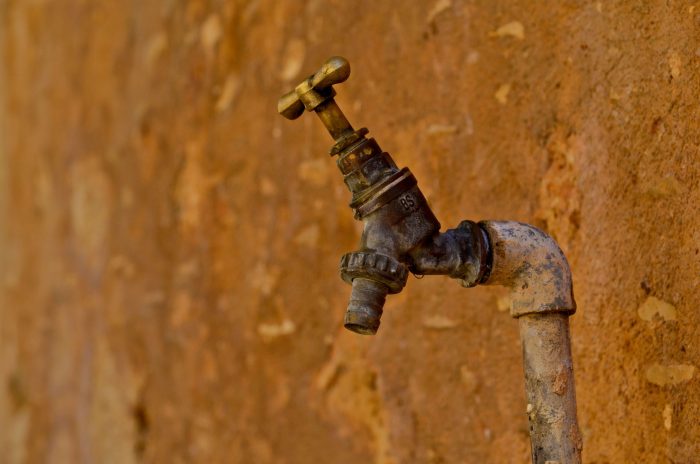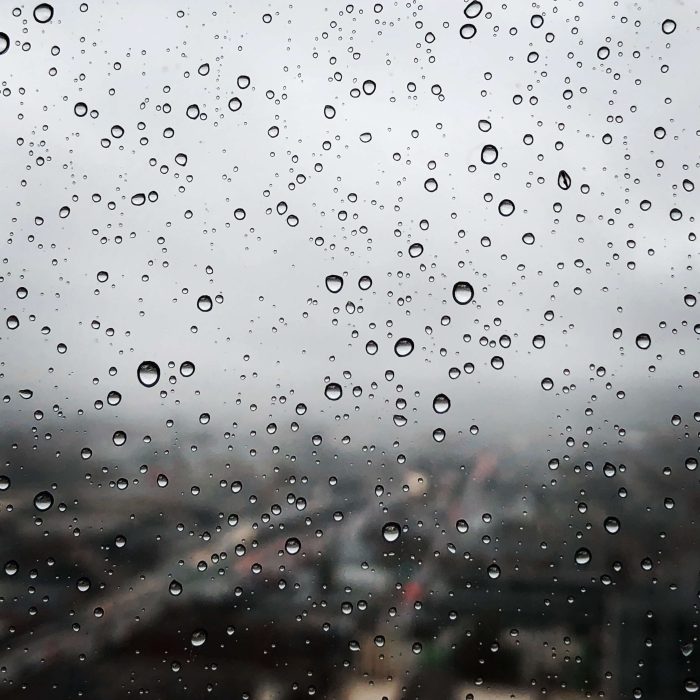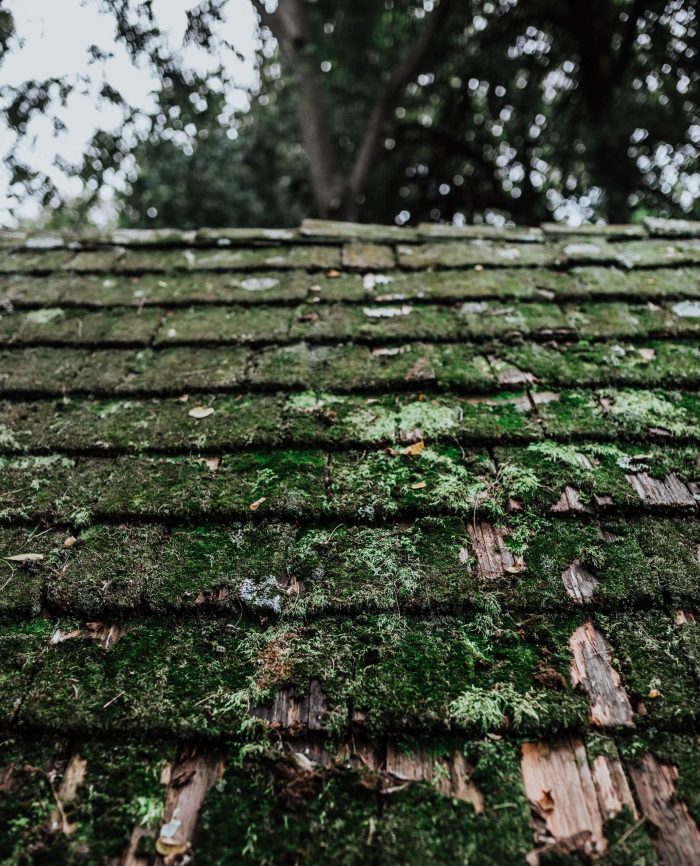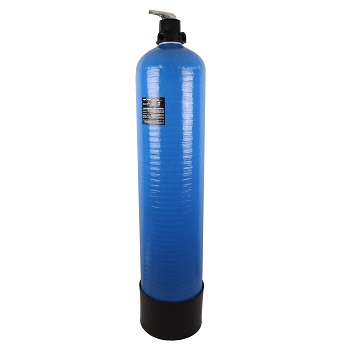
How To Treat Low pH Acidic Water Using Calcite
October 12, 2021 3:55 pm Leave your thoughts
Have you recently noticed blue-green staining around your home’s plumbing? Are your water pipes exhibiting signs of corrosion or pin hole leaks?
You may have acidic water — which is potentially harmful for your health and may cause significant damage to your property.
Acidic water is a fairly common problem in homes across Australia. It is a corrosive force that can damage plumbing and leach toxic heavy metals into your drinking water.
In this guide, I’ll explain what acidic water is and how it occurs. I’ll then share some information on whole house calcite systems and how they can be used to successfully treat acidic water.
If you are already aware of the problems associated with acidic water and are looking for an immediate solution, jump to the section on Our Whole House Calcite Systems.
Products Featured In This Guide
Whole House Calcite Acidic Water Reduction System
Contents
What is Acidic Water?
What Makes Water Acidic?
What Are The Consequences Of Acidic Water?
How Do You Know If Your Water Is Acidic?
How Is Acidic Water Treated?
How Do Calcite Systems Work?
Pros and Cons Of Using A Calcite System
Our Whole House Calcite Systems
What Is Acidic Water?
pH is a scale used to describe the acidity or alkalinity of aqueous solutions, like water. It measures the amount of free hydrogen and hydroxyl ions in a solution. Water with more free hydrogen ions is ‘acidic’, while water with more free hydroxyl ions is ‘basic’, or ‘alkaline’.
The scale runs from 0 (extremely acidic) through to 14 (extremely alkaline). Neutral water has a pH of 7, so water lower than this point is considered acidic.
Most Australian councils will treat their water supply so it is as close to neutral as possible. This helps ensure the water is safe to drink and does not damage local water infrastructure or the plumbing in your home.
However, if you obtain your water from rainfall, streams, lakes, rivers you are drinking untreated water which can sometimes be acidic. Back to top.
What Makes Water Acidic?

Rain Water
Rain water is naturally acidic because of the way the hydrologic cycle works.
When the sun heats up water sources like oceans, lakes, and streams, water evaporates and rises. It then cools and condenses, turning into water vapour and forming clouds.
This process filters the water naturally, leaving behind minerals, bacteria, chemicals, and hardness. It mimics the process of distillation, creating water that is extremely pure.
When it rains, this pure water is returned to the earth. However, because the mineral content of the water has been stripped out, the rainwater that is returned will be soft and acidic (typically between 5-5.5 pH).
This means homeowners gathering rainwater are filling their tanks with slightly acidic water.
If you have an old concrete tank, the pH of your collected rainwater will increase as it absorbs some minerals from the tank wall. However, if you have a metal or poly tank, it can remain acidic, potentially leading to a variety of problems.

Natural Phenomenon
Local waterways including lakes, dams, streams, and rivers can sometimes become acidic due to natural phenomenon like:
- Decomposing organic matter
When organic matter decays in water with dissolved oxygen, the level of carbon dioxide will increase and pH will decrease. This issue can be worse after black water events like flooding and bush fires, which often dump large quantities of organic matter into waterways. - Disturbance of acid sulfate soils
If local acid sulfate soils or salt marshes are disturbed, it can cause the oxidation of iron-sulfides stored in the soil. This can lead to acid drainage (very low pH) which may affect local waterways. This issue has become more common in recent years as a result of climate change.
Air and Water Pollution
Chemicals that are released into the natural environment from factories, landfills, chemical plants, mines, and farms can impact the pH of both natural water bodies and of rainfall.
The release of sulphur dioxide (SO2) and nitrogen oxides (NOX) pollution can cause acid rain to form, which damages plants and can make water unsafe to consume.
Pollutants including pesticides, mine tailings, fertilisers, volatile organic compounds, and synthetic chemicals can have an impact on the pH of local dams, rivers, lakes, and streams.

What Are The Consequences Of Acidic Water?
Damage To Your Home’s Plumping and Appliances
Acidic water can eat away at the metal in your home’s plumbing, fittings, and appliances.
The blue-green staining that homeowners with acidic water see is a result of copper piping corroding and entering the water supply. This staining is considered a red flag in terms of acidic water.
Eventually, the acidic water will eat away so much copper that pinhole leaks begin to form, potentially causing water damage. Replacing your home’s plumbing can cost thousands of dollars, so identifying acidic water issues early on and taking action to correct them is essential.
Having acidic water can also damage appliances including water heaters, radiators, and coffee machines. Any appliances which are heating acidic water are more heavily impacted as the heat magnifies the corrosive effect of the water.
Potential Health Problems
It is perfectly safe to drink water that is slightly above or below 7 pH. In fact, the Australian Drinking Water Guidelines suggest that water between 6.5 and 7.5 pH is safe to consume.
However, acidic water has the ability to leach metals from pipes, plumbing fittings, water tanks, and connecting solder. This means it can introduce iron, manganese, copper, zinc, lead, and other metals into your drinking water.
Some of these metals are toxic to the human body in high levels and can cause a significant impact on your health.
Consuming high levels of copper, for example, can lead to diarrhea, headaches, and in severe cases, kidney failure.
Lead can cause developmental delays, abdominal pain, neurological changes, fatigue, and irritability. In severe cases, lead toxicity can cause organ failure and death.
Researchers have also found that exposure to heavy metals can have an impact on bone health, increasing the risk of conditions like osteopenia/osteoporosis.
Consuming very acidic water may also have an effect on dental health. Although there isn’t much research on acidic water’s effects on dental health, researchers have found that drinking beverages with a pH of lower than 4.5 can damage tooth enamel and increase the risk of tooth decay.
How Do You Know If Your Water Is Acidic?
There are several warning signs which indicate your water may be acidic:
- Greenish/blue stains on your toilet, sinks, shower basin, bathroom tiles, or bathtub.
- Pinhole leaks developing in pipes.
- Obvious corrosion of faucets and fixtures
- Fragile water pipes which can be easily damaged
To confirm that your water is acidic use a pH testing kit or have a sample tested by a laboratory or local Pool Shop.

How Is Acidic Water Treated?
There are several ways to increase the pH of water, but the most frequently used options in Australia are:
Soda ash/sodium hydroxide injection
This option is often used by large scale water treatment facilities which are run by councils. Soda ash (sodium carbonate) and sodium hydroxide are injected into the water system using a corrosion-resistant chemical feed pump. This raises the pH of water without increasing its hardness.
Councils will often inject chlorine at the same time as soda ash/sodium hydroxide to neutralise bacterial, viral, fungal, and protozoan contaminants. Injection systems can treat water with a pH as low as 4.
Calcite (Calcium Carbonate)
Calcite systems are a popular choice for home owners with acidic water as they are affordable, easy to setup, and low maintenance.
They contain hard granules of calcite (calcium carbonate CaCO3), a white or colourless mineral. When exposed to water, the calcite granules dissolves slightly, releasing calcium carbonate into the water. This increases the pH of the water, making it less acidic.
One of the advantages of using calcite to correct acidic water is that it only corrects pH enough to reach a non-corrosive equilibrium. It won’t make your water overly alkaline, leading to other problems.
Calcite can be used on water above 5.4 pH. It is certified to NSF/ANSI Standard 60.
Corosex® (Synthetic magnesium oxide medium)
Corosex® is a synthetic form of magnesia (magnesium oxide, or MgO) which dissolves when exposed to acidic water, increasing the pH of the water.
It can dissolve much faster than calcite, so it acts more aggressively on acidic water. However, unlike calcite, it doesn’t reach a non-corrosive equilibrium and can make water overly alkaline if added incorrectly.
Corosex® can be used on water above 4.5 pH. Many systems will combine a small percentage of Corosex® to the calcite so the system is capable of dealing with low pH but can also form a non-corrosive equilibrium thanks to the calcite. Certified to NSF/ANSI Standard 60.
Note Corosex® can often change the taste of the water and it is recommended to have a carbon filter installed for drinking water in the kitchen.
How Do Calcite Systems Work?
Most calcite systems are large vessels that are installed on the main water line. In most systems, the water enters a central tube inside the vessel, flowing to the bottom then pushing back up through the media. These systems are called reverse or up flow systems.
The vessel will have a bed of gravel on the bottom to help spread the flow of water and to keep the calcite in position. Water flows through the gravel then through the bed of calcite. As it touches the calcite, calcium carbonate is dissolved into the water, increasing the pH of the water.
The incoming water must have sufficient contact time with the calcite to release calcium carbonate. This means larger vessels are required to support high flow rates. Typical household systems will use a vessel that is 52” tall and holds about 60kgs of calcite.
The simple design of calcite systems means very little maintenance is required. You will only need to check the level of the calcite every few months and add more if required.
Systems that require Corosex® are normally run in a down flow, allowing the Corosex® to be added on top of the Calcite.
What Do Different Calcite Grades Mean?
Calcite used for domestic purposes is usually sold in bags labelled as grade 1, 2 or 3. The grades refer to the size of the calcite pieces, with grade 1 being the smallest and grade 3 the largest.
Using a smaller grade offers several advantages but also some disadvantages.
Having finer granules means there is less chance of bypass occurring as water flows through the vessel.
Smaller granules of calcite will also dissolve faster, which makes them capable of correcting water that is a lower pH. This also means that you may be able to use a smaller vessel for pH correction.
The main downside of using a finer grade of calcite is that more maintenance may be involved as it dissolves faster. This can also make the system more expensive to operate.
In general, we recommend that people with pH at 6.2 and above use grade 2 calcite. If yout pH is in the 5.9-6.2 range, then smaller grade calcite would be a better option. Below this point, Corosex also needs to be introduced to the system.
Pros and Cons Of Using Calcite To Correct pH
Pros Of Using A Calcite System
Safe and Effective
Calcite has a strong track record in Australia with thousands of homeowners, businesses, and government facilities using calcite systems to treat their water. Because calcite is a natural form of media, there is no risk of chemical exposure or toxicity. It naturally brings the pH of your water back to a level close to pure water, making your water safe to drink.
Reliable and low maintenance
The simple design of calcite systems makes them a simple and no fuss method for improving water pH. All you need to do is have the system installed by a plumber, then top up your calcite as needed.
Because calcite systems reach a non-corrosive equilibrium, there are no frequent adjustments or water testing regimes required. You won’t have to worry about over correction. It is a set and forget system that only needs to be checked every 6-12 months depending on your water quality.
Affordable
The cost of a calcite system is much lower than the expense of re-plumbing your entire home due to corrosion of copper pipes.
After the initial expense of purchasing a calcite system and having it installed by a plumber, running costs are very low. You will just need to top up the vessel with calcite.
For most households, this will involve the addition of 10 to 20 kg of calcite per year. Given that a 20kg bag costs between $80.00 to $90.00, this is extremely affordable.
The metal housing and plumbing fixtures will last many years, which makes it a great long term option for correcting water acidity.
Cons Of Using A Calcite System
Every water treatment system will have some drawbacks. When it comes to using calcite to treat acidic water, the downsides are very limited. They include:
It can contribute to scale formation
As mentioned earlier, calcite works by slowly introducing calcium carbonate into your water, which increases the pH of acidic water. Unfortunately, adding more calcium increases the hardness of your water.
If you are living in SA, WA, or the NT, where the water is already quite hard, this may increase the risk of limescale developing on your taps, shower cubicle, and appliances.
One possible solution to this issue is to use a filter containing polyphosphate after the calcite system. Polyphosphate is a natural substance that is capable of locking up calcium carbonate so it can’t harden to form scale. It is a very popular product amongst people with hard water.
Calcite needs contact time to work
One of the limitations of using calcite to improve water pH is that it dissolves slowly. This means it needs a lot of contact time with your acidic water. As a result, you will need a reasonably large vessel to accommodate high flow rates.
Space is required
Household calcite vessels are usually over a metre tall and 30cm wide. This vessel needs to placed in a location where it can be inserted into your main water line. You will need to find a location to place the vessel.

Our Whole House Calcite Systems
We have created an affordable calcite system for households which is capable of treating water that is pH 5.4 and above. It comes with:
- 52” x 12” Metal Vessel with 1” inlet and outlet ports
- 1 x 20kg bag of bottom under bed gravel
- 3 x 20kg bags of Calcite media
- Brass non return valves and screwed brass union fittings for the inlet and outlet sides (this makes servicing the system easy and to prevent back flow)
This large media vessel provides a long contact time for the incoming water, achieving pH correction at flow rates of up to 40 litres per minute. This system does not need any power to operate.
It is a simple natural process of the pH correction which brings your water back to neutral (7-7.5 ph).
Corosex® can be added to the calcite if your water’s pH is lower than 5.6. It can successfully treat water with a pH as low as 4.6-4.8 (effectiveness varies based on water quality)
Wrapping Up
As you see, acidic water can pose a significant threat to your home’s plumbing and the health of your family. Fortunately, it is relatively simple to correct using a calcite system. For more information on acidic water or calcite, contact us today:
Clarence Water Filters Pty Ltd
Phone: 02 6646 8565
Email: sales@clarencewaterfilters.com.au
Tags: Acid Water, Acidity, Calcite, Copper, Copper ToxicityCategorised in: Contaminants
This post was written by Paul
